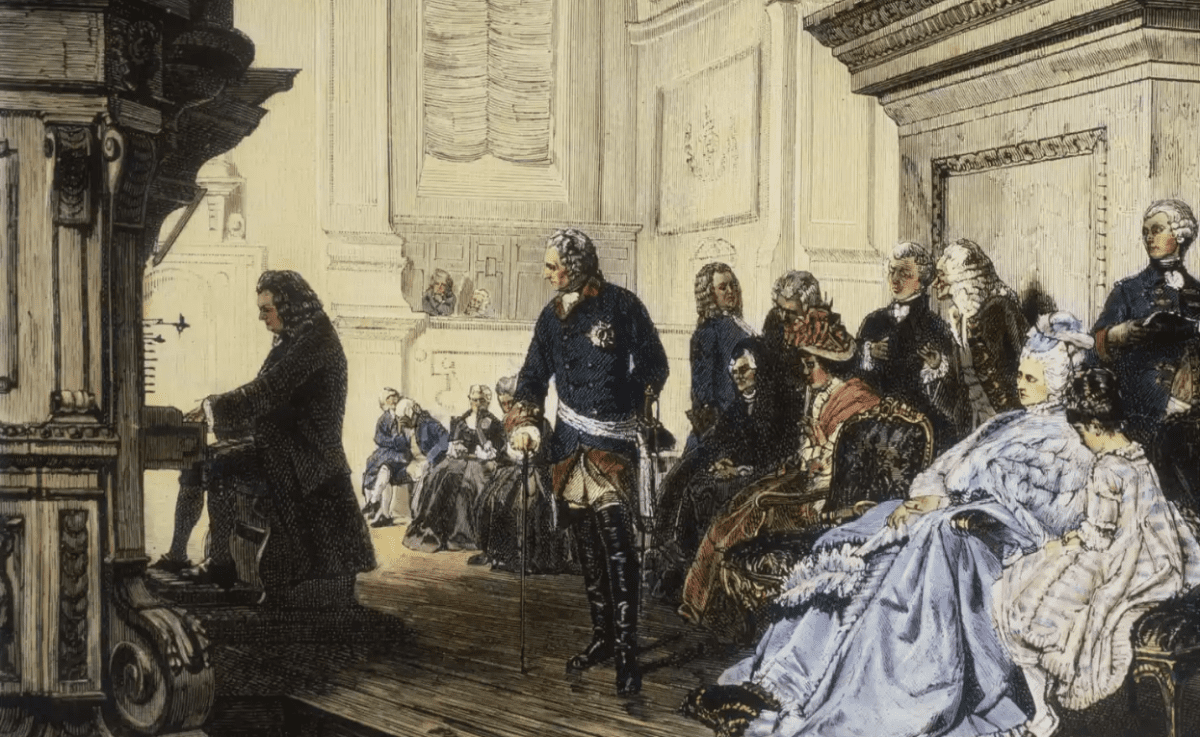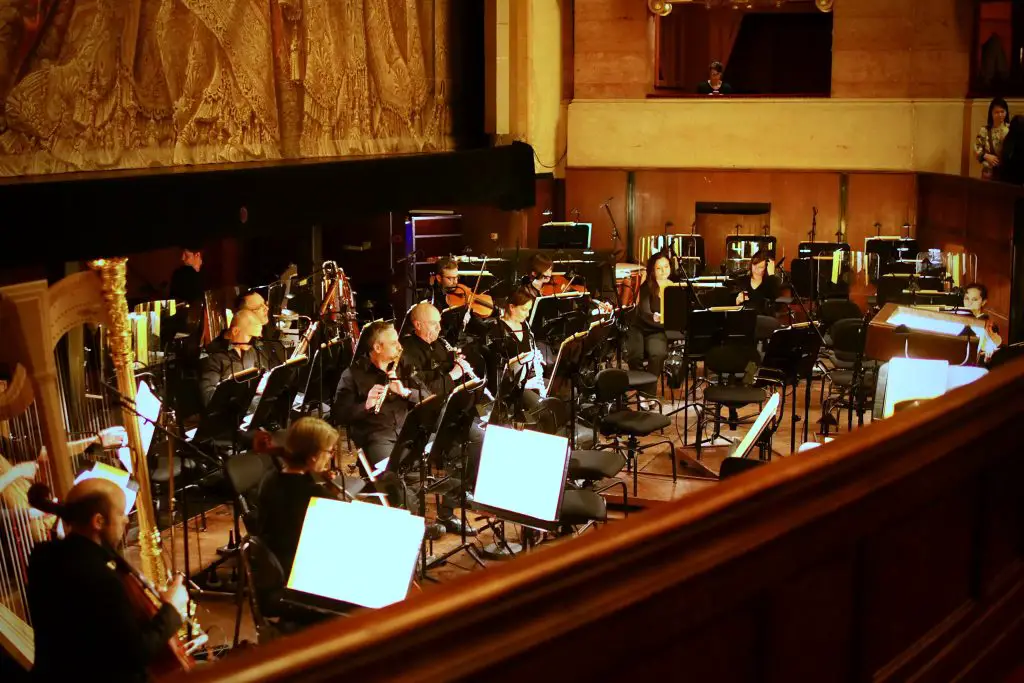Immerse yourself in a time of grandeur and ornamentation, when music was an opulent tapestry woven with intricate melodies and harmonies. Welcome to the Baroque period of music, a time of innovation and discovery that forever changed the landscape of classical music. Do you ever wonder how this era’s influence echoes in the music we listen to today?
What does baroque mean? It’s a term originating from the Portuguese word “barroco,” meaning misshapen pearl, and it’s used to describe an overly ornate and extravagantly detailed style of art, architecture, and, of course, music that was popular from 1600 to 1750.
How did the Baroque period of music begin?
From the Renaissance’s ashes rose the Baroque period, a transformative epoch in the world of music, where composers dared to experiment and push the boundaries of musical expression. The shift began in Italy, with composers like Alessandro Scarlatti and Claudio Monteverdi introducing new harmonic and ornamental frameworks that would later become the bedrock of Baroque music.

Alessandro Scarlatti and his son Domenico Scarlatti were among the torchbearers of this innovative period. Both were known for their dramatic and expressive compositions. If you’re looking for music that truly exemplifies the spirit of the Baroque period, their work would be an excellent starting point. Antonio Corelli, another Italian composer, also played a pivotal role in this era with his contributions to the development of the concerto grosso and violin technique.
Taking inspiration from the Baroque era, we’ll find that the integration of intricate harmonies and dramatic tonal shifts can inject our compositions with a level of depth and emotion that captivates our audience.
As the Baroque period matured, Antonio Vivaldi emerged as a key figure. His renowned piece “The Four Seasons,” filled with energetic allegros and dramatic adagios, is the musical equivalent of binge-watching a season of “Game of Thrones”—full of excitement, suspense, and moments of deep emotion.
In your home recording studio, the influence of these Italian maestros can be felt in the creation of expressive and dramatic pieces. Taking inspiration from the Baroque era, we’ll find that the integration of intricate harmonies and dramatic tonal shifts can inject our compositions with a level of depth and emotion that captivates our audience.
AKAI Professional MPK Mini MK3

AKAI Professional MPK Mini MK3
Did Baroque music only flourish in Italy?
Certainly not! The Baroque period witnessed a cultural exchange that led to the evolution of music styles across Europe. As musicians traveled, the Baroque style caught on, with each country adding unique elements to the burgeoning music form.
Germany, France, and England were major players. The likes of Henry Purcell in England and Jean-Baptiste Lully and Jean-Phillippe Rameau in France all made their mark. However, it was the German school of Baroque music, led by composers like Georg Philipp Telemann, Johann Pachelbel, and most notably, Johann Sebastian Bach, that was highly influential.
Interestingly, George Frideric Handel, another prominent German, spent nearly his entire career in England. If you’ve ever listened to Handel’s “Water Music” or his English-language oratorio “Messiah,” you’ve experienced firsthand the transformative power of Baroque music.
Bach, Handel, and Vivaldi are the three most well-known Baroque composers. To better understand their distinct styles, let’s take a glance at some of their most iconic works with this table:
| Composer | Composition | Instrumentation | Key Features |
|---|---|---|---|
| J.S. Bach | Brandenburg Concerto No. 3 | Strings and Harpsichord | Intricate polyphonic texture, use of basso continuo |
| G.F. Handel | Messiah | Orchestra, Choir, and Soloists | Dramatic use of dynamics and choral sections |
| A. Vivaldi | The Four Seasons | Solo Violin and String Orchestra | Vivid programmatic elements, virtuosic violin passages |
In the realm of music production today, Germany’s influence persists. Look at the complexity and depth of modern electronic music; you’ll notice patterns and textures reminiscent of Bach’s fugues or Handel’s concertos. It’s like discovering a hidden Easter egg in your favorite video game – subtle but so satisfying when you spot it.
What are the significant forms of music from the Baroque period?
From the stirring sounds of operas to the resonating tones of oratorios, the Baroque period was characterized by an explosion of musical forms. Composers explored new territories, introducing an array of styles that set the stage for future generations.
1. Prelude and fugue
If we’re talking Baroque, we can’t ignore the fugue, a complex and intricate composition style. Bach’s “The Well-Tempered Clavier” showcases the beauty of this form.
2. Cantata
This vocal composition with an instrumental accompaniment was a favorite during the Baroque era. Bach’s approximately 200 cantatas prove this point.
3. Concerto
Pieces like Vivaldi’s “Four Seasons” or Handel’s “Water Music” demonstrate the mastery of the Baroque concerto.
4. Oratorio
Oratorios are large-scale musical compositions for orchestra, choir, and soloists. Handel’s “Messiah” is one of the most famous examples.
5. Sonata
Sonatas were instrumental compositions in several movements. Scarlatti’s keyboard sonatas are among the best of the period.
6. Opera
Operas were the Marvel Cinematic Universe of the Baroque period – grand, dramatic, and thoroughly entertaining. Vivaldi and Handel were the Stan Lees of their time, crafting musical narratives that enthralled their audiences.
Looking at the diversity of these forms, it’s clear how they continue to influence modern music production. Every EDM drop, every sweeping film score, even the catchy jingle in the latest car commercial – they all owe something to the pioneers of the Baroque era.

What characterizes Baroque music?
The Baroque era was a time of innovation and musical discovery. From its daring dynamics to intricate ornamentation, the period was marked by a unique musical identity that still resonates today.
Here’s a quick breakdown of its key characteristics:
- Dynamic Variety: Baroque music brought in a range of dynamics, from whispers to roars. The pianoforte’s introduction marked a game-changing moment in music history, enabling a new level of expressiveness.
- Instrumental Focus: While vocals were still prevalent, the Baroque period saw a greater emphasis on instrumental music. Bach’s “Brandenburg Concertos” is a prime example of this shift.
- Ornamentation: Baroque composers loved their embellishments, much like how we enjoy adding filters and effects to our Instagram posts. Trills, turns, and mordents added flavor to melodies.
- Basso Continuo: A staple in Baroque compositions, this system of notation provided a solid harmonic foundation on which melodic lines could dance.
How does this tie back to music production, you ask? Well, let’s break it down. Dynamics help create emotion in your track; varied instrumentation adds texture and richness; ornamentation – think of your favorite guitar riff or EDM synth line. As for the basso continuo, it’s like the bassline in modern music, providing the groove that keeps us moving.
Finally, here’s a simple table of dos and don’ts to consider when composing or producing music inspired by the Baroque period:
| Dos | Don’ts |
|---|---|
| Experiment with dynamics | Stick to a single dynamic level |
| Incorporate a variety of instruments | Limit yourself to a single instrument |
| Add ornamentation for flavor | Overuse ornamentation and clutter your piece |
| Use a steady bassline (basso continuo equivalent) | Ignore the importance of a solid bassline |
Advantages and disadvantages of emulating Baroque techniques
Exploring historical musical techniques, such as those used in the Baroque period, can offer a wealth of benefits. However, it’s also important to acknowledge some potential downsides. Let’s examine some of the pros and cons of incorporating Baroque techniques into modern music production.
Advantages of emulating Baroque techniques
Before we dive into specifics, let’s acknowledge that learning from the past often opens new horizons for the future.
- Deeper understanding of music theory: Baroque music is often complex and can boost your understanding of music theory.
- Development of technical skills: Emulating intricate Baroque compositions can improve your instrumental or compositional skills.
- Unique sound: Mixing Baroque techniques with modern ones can result in a distinct and creative sound.
Disadvantages of emulating Baroque techniques
While there’s much to gain, let’s also consider potential hurdles when integrating Baroque elements into modern music.
- Complexity: Baroque music’s complexity might feel overwhelming, especially for beginners.
- Time-consuming: Mastering Baroque techniques can take time and patience.
- Risk of sounding outdated: If not well-integrated, the use of Baroque techniques might make the music sound out of place in a modern context.
If you want even more tips and insights, watch this video called “The Baroque Period of Music” from the Musical-Things YouTube channel.
Frequently asked questions (FAQ)
Do you still have questions about the Baroque period? Below are some of the most commonly asked questions.
Why is the Baroque period so important in music history?
The Baroque period, spanning from 1600 to 1750, was a time of drastic innovation and expansion in the realm of music. It gave birth to many musical forms we use today, like the opera, the concerto, and the sonata. Moreover, it marked a shift towards more emotional and expressive compositions, paving the way for later periods.
How does the Baroque style differ from other musical periods?
Baroque music is generally characterized by its complex polyphonic texture and the use of basso continuo. It often involves intricate counterpoint, which differs from the more homophonic, melody-focused music of the Classical period that followed. The ornamentation and embellishment in Baroque music also set it apart.
Can I use Baroque techniques in electronic music production?
Absolutely! Using Baroque techniques can give your electronic music a unique twist. Think about adding Baroque-inspired melodic lines or emulating the polyphonic textures in your tracks. It might be an old style, but when used creatively, it can sound refreshingly new.
Conclusion
We’ve taken a grand tour through the halls of the Baroque period, from its ornate lobbies to its high-ceilinged concert halls. We’ve explored the masterworks of Bach, Handel, and Vivaldi and even found out how to give our tracks a Baroque makeover. I’d say we’ve done pretty well, wouldn’t you agree?
Did I strike a chord with all this talk of Baroque? I read and reply to every comment, so let me know what you think below. If you found this guide helpful, share it with a fellow music enthusiast. Be sure to check out the rest of my blog for more insights into the fascinating world of music. Thanks for reading, and as they say in Baroque music, “keep it ornate and articulate!”
Key takeaways
We’ve ventured through the grandeur of the Baroque era in this article. Here are some key takeaways:
- Baroque music is characterized by its complex polyphonic texture and use of basso continuo.
- Bach, Handel, and Vivaldi are the three most well-known Baroque composers, and each had a distinct style within the Baroque framework.
- Learning from the Baroque period can enhance your understanding of music theory and improve your technical skills.
- Incorporating Baroque techniques into modern music production can result in a unique sound, but it does come with its challenges.
- Baroque techniques can be used in various genres, including electronic music.















